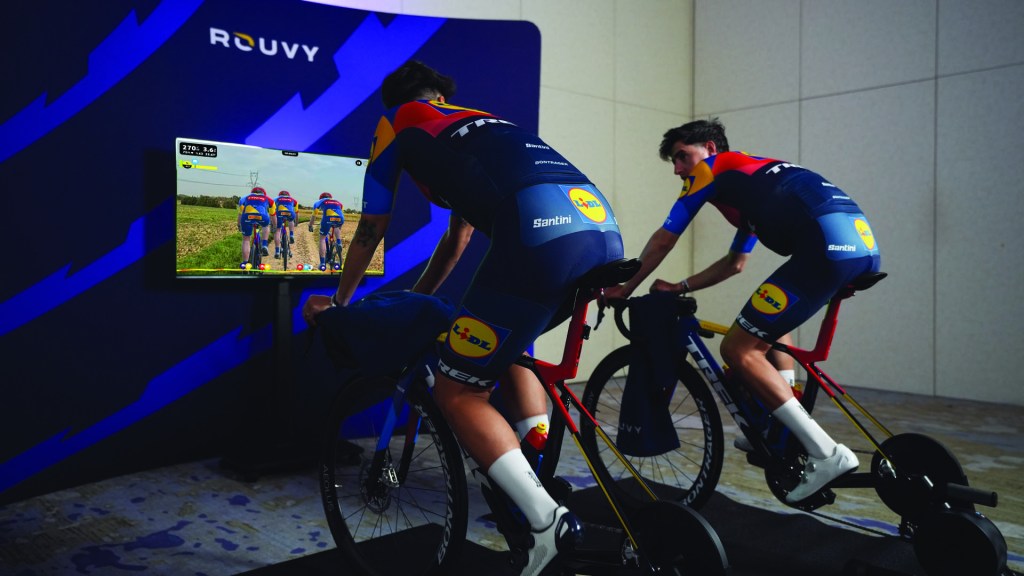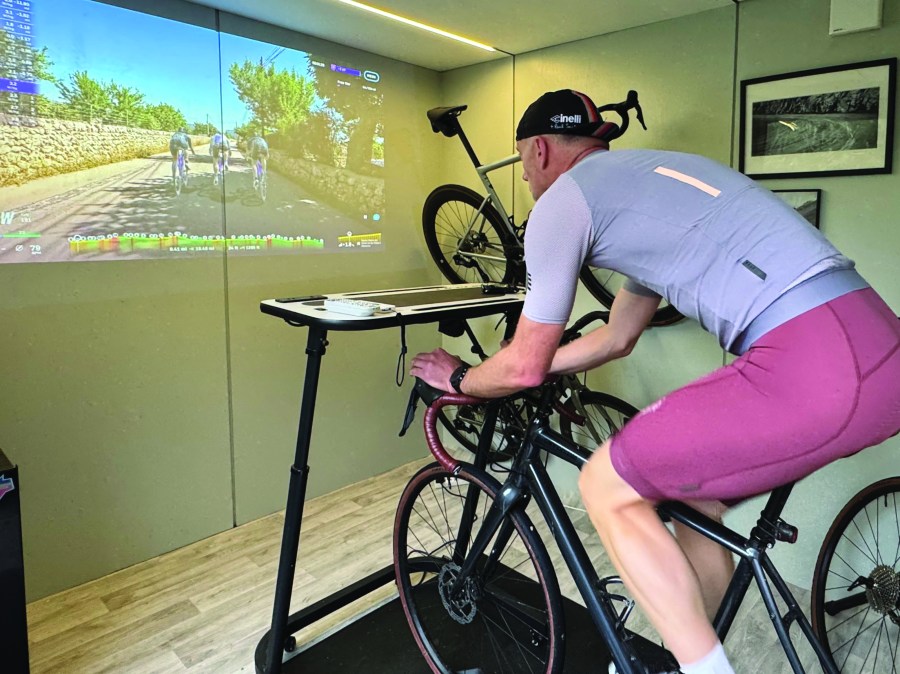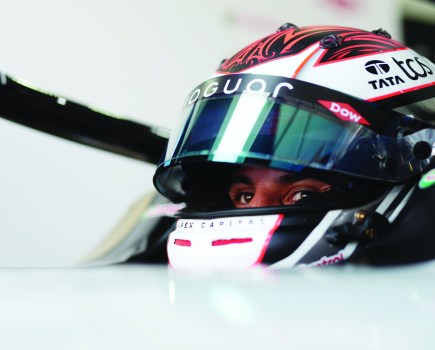Can you improve your cycling fitness in six weeks without leaving the house? Frank Bauer takes the Rouvy app for a spin to find out
There has been a huge growth in indoor cycling apps and one of the newest kids on the block is Rouvy, which positions itself as “the world’s most realistic cycling app”.
Other apps focus on ‘gamifying’ indoor cycling and creating a virtual world; Rouvy focuses on high-quality video and augmented reality to transport riders to real-world global locations.
My brief was simple, if not easy: complete 2 training sessions per week for 6 weeks and see if you can improve your cycling fitness. To help make sure that the sessions were as effective as possible, they were to be selected from the workout files of Lidl Trek, one of the world’s best cycling teams, and the process was to be overseen by their Head of Performance, Mattias Reck.
To implement the training sessions, I used the cycling app Rouvy, which, with a home trainer and an internet connection, allows you to ride with others on thousands of courses curated from around the world using real life footage.
In addition, Rouvy provides the opportunity to race or ride virtual events, complete challenges, follow training plans, such as Lidl Trek’s, or just execute a workout. Although I’ve used several other cycling apps over the years, I had never used Rouvy, but it’s very easy to set-up and I was up and running in minutes.

First things first
To set a baseline measurement and allow the training sessions to be tailored specifically to my current level of fitness, I completed Rouvy’s FTP Ramp Test. FTP (functional threshold power) is an estimation of the highest average power that you can hold for an hour. Within the cycling world it is commonly used as a proxy for fitness (although in reality it only measures one aspect).
For the test, you simply choose a route from Rouvy’s vast library, quite possibly one that you believe will distract you from the upcoming pain for the longest, press start, and then pedal. The Rouvy app leads you in gently with a 5-minute warm-up and then proceeds to increase the resistance every minute in even steps until you reach the point that you can’t maintain target power anymore.
Once you’re spent, it calculates your FTP based on a percentage of your best one-minute average power. There are other ways of measuring FTP, but the ramp test has the particular advantages of being: relatively short, the whole process including warm-up and down can be completed in around 30 minutes; doesn’t require pacing, which can be particularly difficult to judge, especially if you’re fairly new to cycling; and the window of pain is much shorter, which means you’re probably more likely to repeat the experience in order to keep track of how your fitness is developing.
Building a plan
After completing the test, I then had a brief discussion with Mattias filling him in on my recent training history, leading to his matter-of-fact assertion via text that ‘you can train hard from day 1 :-)’. This was not the emoji I would have used.
I have followed cycling training plans most years for at least the last 10, and these have almost exclusively followed the traditional approach of building a solid aerobic base before adding interval sessions and harder efforts to improve speed and punch. Mattias assessed that with the very limited time frame we were working to, we needed to approach things differently and instead follow a reverse periodisation with a focus on HIT sessions. This is a commonly used method and introduces shorter, higher intensity workouts early in the training plan. His guidance being the sessions should be done not necessarily after a rest day, but when fresh and well recovered.
So, week 1, session 1: VO2 max 30-15 intervals, alarmingly titled ‘PROPER VO2 MAX SESSION by Mattias Reck’. I’m fairly certain that Einstein’s assertion in his theory of relativity that time passes at different rates for observers in different frames of reference came to him after a particularly gruelling VO2 interval session. Where 30 seconds of effort quickly becomes enough time to circumnavigate the earth, on foot, and 15 seconds of recovery disappears before you’ve had time to take a drink.
When they’re pitched correctly – and this is where conducting an initial FTP test comes into play – you find that you settle into a rhythm of having just enough to complete the effort and then just enough recovery to start the next. Mattias’s session consists of 4 sets of 11 repetitions of 30 seconds hard, 15 seconds easy. The beauty of doing this sort of session on Rouvy is that the resistance is automatically adjusted for you, so all you have to do is keep pedalling at the target power. The initial two weeks entailed solely these workouts.

Safety first
Another benefit of riding on one of the many virtual routes on Rouvy, as opposed to the open road, is that you don’t have to share the space with traffic and you’re very unlikely to crash.
The same cannot be said when out riding in early March, on a damp morning in the UK. With the roads greasy from some light rain, and my approach to a roundabout being a little over eager, largely due to my wish to get off a busy A road, I managed to lose my front wheel and slide across the tarmac on my hip and elbow.
Fortunately, nothing was broken on either me or my bike. Much of my kit was ruined: bib-tights, overshoes, long sleeve jersey and rain jacket all ripped. I also suffered significant road rash to my hip and elbow, the scars from which are still evident some four months later. On the plus side, however, and despite the discomfort, I was still able to ride and so could continue with the training into the third week.
Mattias prescribed sticking with a 30-15 workout for the first session of the week before moving on to more specific FTP/threshold training. This consisted of two sets of five repetitions of 3 minutes slightly above threshold followed by 1 minute easy (3-1s). By this stage, being only 3 weeks into the challenge, I already felt stronger, particularly on the short 3-sminute threshold intervals and was able to increase the resistance slightly on the fly from within the workout on the Rouvy app. If nothing else, Mattias’s simple approach proved to me that you don’t really need any complex sessions to improve your base fitness.
I continued with these threshold sessions in the fourth week before changing things up slightly for the final two weeks with workouts combining low VO2 and threshold work. The first of these involved 4 sets of 8 minutes at threshold but with 3 x 30 second efforts at VO2 max interspersed throughout each block. The second workout took the 3-1s from weeks 3 and 4 and increased each effort to three-and-a-half minutes while at the same time reducing the recovery to 30 seconds.
With the 6 weeks of training over, it was now a case of having a couple of easy days before undertaking another FTP Ramp Test. The results of undertaking two sessions per week on Rouvy under the guidance of Mattias were pretty conclusive: my FTP improved by 12% over the period, undoubtedly helped by the fact that my cycling fitness was relatively low coming into the programme, but nevertheless, a significant improvement.
If I had to raise one shortcoming of my experience on Rouvy, it’d be that I didn’t encounter other riders on the platform whilst I was doing the workouts. Instead, Rouvy generates other avatars so that you feel like you’re riding in a small bunch. I imagine that as the platform becomes more popular, this will change, and the more popular routes should be increasingly populated with other riders.
However, having access to workouts that have been prepared by one of the world’s best coaches, Lidl Trek have achieved over 30 professional victories so far in 2025 alone, gives you a degree of confidence that your hard efforts are going to produce results, and being able to do this while immersed in real life routes through the Rouvy app is a great way of improving your cycling fitness.






